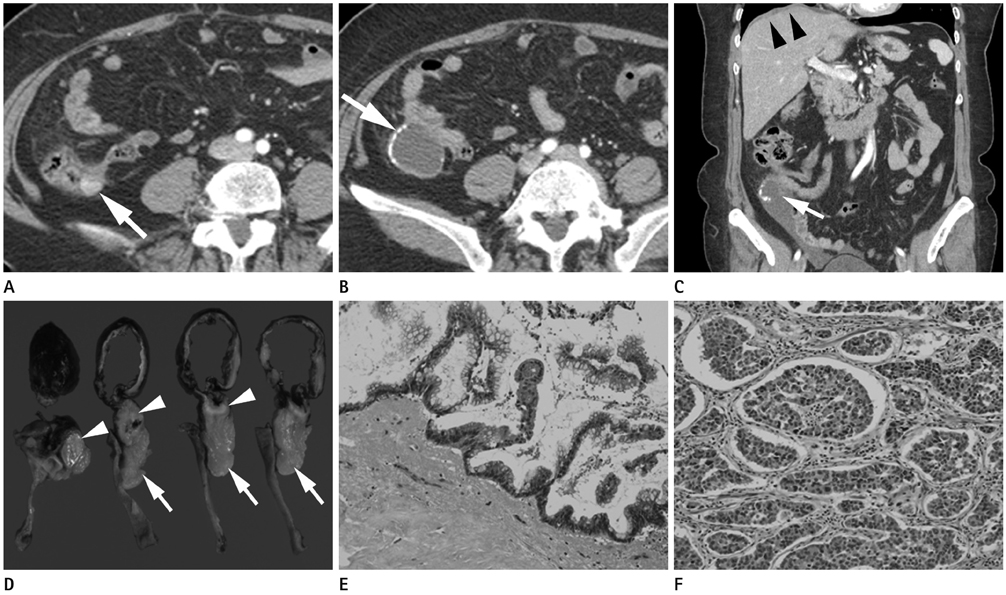J Korean Soc Radiol.
2014 May;70(5):355-358. 10.3348/jksr.2014.70.5.355.
The Combination of Neuroendocrine Tumor and Mucinous Neoplasm of the Appendix: A Case Report
- Affiliations
-
- 1Department of Radiology, Pusan National University Hospital, Pusan National University School of Medicine, Busan, Korea. leenk77@hanmail.net
- 2Department of Pathology, Pusan National University Hospital, Pusan National University School of Medicine, Busan, Korea.
- 3Department of Surgery, Pusan National University Hospital, Pusan National University School of Medicine, Busan, Korea.
- KMID: 1941781
- DOI: http://doi.org/10.3348/jksr.2014.70.5.355
Abstract
- Primary neoplasm of the appendix is an uncommon pathology, representing 0.5-1% of all appendix specimens. Especially, simultaneous occurrence of two tumors of the appendix was rarely documented. We report a case of the concomitant neuroendocrine tumor and the mucinous neoplasm of the appendix on abdominal computed tomography, in a 62-year-old female who came for a check-up.
Figure
Reference
-
1. Pickhardt PJ, Levy AD, Rohrmann CA Jr, Kende AI. Primary neoplasms of the appendix: radiologic spectrum of disease with pathologic correlation. Radiographics. 2003; 23:645–662.2. Cho JB, Cho HJ, Shin OR, Kim KH, Ahn CH, Kim JS, et al. Clinical findings of appendiceal mucocele. J Korean Surg Soc. 2008; 74:429–435.3. Paik BL, Kim AR, Lee JH, Lee SB, Kim H, Park SJ, et al. The analysis of appendiceal mucocele with emphasis on the colonoscopic findings. Korean J Gastrointest Endosc. 2005; 30:243–248.4. Stocchi L, Wolff BG, Larson DR, Harrington JR. Surgical treatment of appendiceal mucocele. Arch Surg. 2003; 138:585–589. discussion 589-590.5. Brustmann H. Myxoglobulosis of the appendix associated with a proximal carcinoid and a pseudodiverticulum. Ann Diagn Pathol. 2006; 10:166–168.6. Alsaad KO, Serra S, Chetty R. Combined goblet cell carcinoid and mucinous cystadenoma of the vermiform appendix. World J Gastroenterol. 2009; 15:3431–3433.7. Rakovich G, Larue N. Mucocele of the appendix associated with a carcinoid of the terminal ileum. Can J Surg. 2007; 50:66–67.8. Carr NJ, Remotti H, Sobin LH. Dual carcinoid/epithelial neoplasia of the appendix. Histopathology. 1995; 27:557–562.9. Chang S, Choi D, Lee SJ, Lee WJ, Park MH, Kim SW, et al. Neuroendocrine neoplasms of the gastrointestinal tract: classification, pathologic basis, and imaging features. Radiographics. 2007; 27:1667–1679.10. Griniatsos J, Michail O. Appendiceal neuroendocrine tumors: recent insights and clinical implications. World J Gastrointest Oncol. 2010; 2:192–196.
- Full Text Links
- Actions
-
Cited
- CITED
-
- Close
- Share
- Similar articles
-
- Pancreatic Collision Tumor of Desmoid-Type Fibromatosis and Mucinous Cystic Neoplasm: A Case Report
- A Case of Pseudomyxoma Peritonei with Primary Borderline Mucinous Tumors of the Ovary and Appendix
- Ovarian Large Cell Neuroendocrine Carcinoma Associated with Endocervical-like Mucinous Borderline Tumor: A Case Report and Literature Review
- Gastrointestinal Stromal Tumor of the Appendix Mimicking a Mucinous Cystadenocarcinoma: A Case Report
- Incidental Carcinoid of Appendix in Borderline Mucinous Ovarian Tumor


